Museum of Ixelles
- View a machine-translated version of the Dutch article.
- Machine translation, like DeepL or Google Translate, is a useful starting point for translations, but translators must revise errors as necessary and confirm that the translation is accurate, rather than simply copy-pasting machine-translated text into the English Wikipedia.
- Do not translate text that appears unreliable or low-quality. If possible, verify the text with references provided in the foreign-language article.
- You must provide copyright attribution in the edit summary accompanying your translation by providing an interlanguage link to the source of your translation. A model attribution edit summary is
Content in this edit is translated from the existing Dutch Wikipedia article at [[:nl:Museum van Elsene]]; see its history for attribution. - You may also add the template
{{Translated|nl|Museum van Elsene}}to the talk page. - For more guidance, see Wikipedia:Translation.
50°49′54″N 4°22′20″E / 50.83167°N 4.37222°E / 50.83167; 4.37222
The Museum of Ixelles (French: Musée d'Ixelles; Dutch: Museum van Elsene), also called the (Municipal) Museum of Fine Arts of Ixelles (French: Musée (communal) des Beaux-Arts d'Ixelles; Dutch: (Gemeentelijk) Museum voor Schone Kunsten van Elsene), is a municipal art museum in Brussels, Belgium, focusing on Belgian art from the 19th and 20th centuries.
The museum is located at 71, rue Jean Van Volsem/Jean Van Volsemstraat in Ixelles.[1] It is served by the bus stops Musée d'Ixelles/Museum van Elsene (on line 71)[2] and Malibran (on lines 38 and 60).[3][4]
History
The Museum of Fine Arts of Ixelles was founded in 1892 to house a collection of works donated by the painter and collector Edmond De Pratere and grew rapidly with donations from generous patrons such as Léon Gauchez (1825–1907), Fritz Toussaint (1846–1920) and Max Janlet (1903–1976). The art patron Octave Maus (1856–1919) donated more than 200 impressionist, neo-impressionist and symbolist works.[5]
In 2018, the museum closed for renovations and an expansion. It is planned to reopen in 2023.[6]
Curators
The curators of the museum have been:[5]
- 1902–1926: Emile Meunier
- 1929–1956: Jean-Joseph Hoslet
- 1957–1987: Jean Cockerel
- 1987–2007: Nicole d'Huart
- 2007–present: Claire Leblanc
Collection
The museum presents a panorama of Belgian art of the 19th and 20th centuries. The collections bring together paintings, sculpture, and drawings representing the different art movements of this time. A sampling of Flemish masters and some representatives of foreign schools complete the set. A collection of posters includes a complete collection of originals by Henri de Toulouse-Lautrec.[5][7] The museum also regularly organises temporary exhibitions and has a documentation centre.[citation needed]
-
 Portrait of Jeanne Meunier, Constantin Meunier
Portrait of Jeanne Meunier, Constantin Meunier -
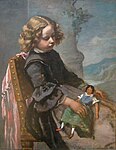 Child with a doll, Eugène Smits
Child with a doll, Eugène Smits -
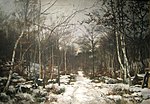 The Sonian Forest, Joseph Coosemans
The Sonian Forest, Joseph Coosemans -
 Young girl by the sea, Charles Hermans
Young girl by the sea, Charles Hermans -
 The young ladies van den Perre, Jan Verhas, 1887
The young ladies van den Perre, Jan Verhas, 1887 -
 Senette in Ruisbroek, Guillaume Vogels
Senette in Ruisbroek, Guillaume Vogels -
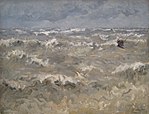 Turbulent sea, Isidore Verheyden, 1893
Turbulent sea, Isidore Verheyden, 1893 -
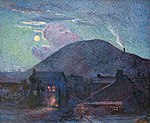 Terril of the coal mine, Maximilien Luce, 1896
Terril of the coal mine, Maximilien Luce, 1896 -
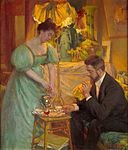 The tea (Portrait of Juliette and Rodolphe Wytsman), Herman Richir, c. 1898
The tea (Portrait of Juliette and Rodolphe Wytsman), Herman Richir, c. 1898 -
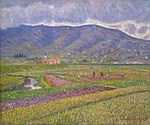 May rain. Basque Country, Dario De Regoyos, 1902
May rain. Basque Country, Dario De Regoyos, 1902 -
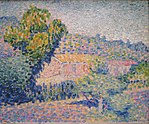 Pink house, Henri-Edmond Cross, c. 1901–1905
Pink house, Henri-Edmond Cross, c. 1901–1905 -
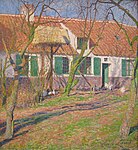 Farm in Flanders, Emile Claus, 1904
Farm in Flanders, Emile Claus, 1904 -
 Nude, Georges Lemmen, 1907
Nude, Georges Lemmen, 1907 -
 Spirea, Juliette Wytsman
Spirea, Juliette Wytsman -
 House by the water, Paul Mathieu, 1918
House by the water, Paul Mathieu, 1918
See also
- List of museums in Brussels
- Art Nouveau in Brussels
- History of Brussels
- Culture of Belgium
- Belgium in the long nineteenth century
References
Citations
- ^ "Practical information". Musée d'Ixelles. Retrieved 28 May 2016.
- ^ "Ligne 71 vers DE BROUCKERE - stib.be". www.stib-mivb.be. Retrieved 13 January 2023.
- ^ "Ligne 38 vers - stib.be". www.stib-mivb.be. Retrieved 13 January 2023.
- ^ "Ligne 60 vers AMBIORIX - stib.be". www.stib-mivb.be. Retrieved 13 January 2023.
- ^ a b c "History". Museum of Ixelles. Retrieved 28 May 2016.
- ^ "Renovations". Museum of Ixelles. Retrieved 16 March 2022.
- ^ "The permanent collections — Museum of Ixelles". www.museumofixelles.irisnet.be. Retrieved 16 December 2023.
Bibliography
- Anne Carre, Isabelle Six, Claire Leblanc and Marianne Fournier, Musée d'Ixelles. Les collections (in French), Brussels, Silvana Editoriale, 2010
External links
 Media related to Museum of Ixelles at Wikimedia Commons
Media related to Museum of Ixelles at Wikimedia Commons- Official website

























